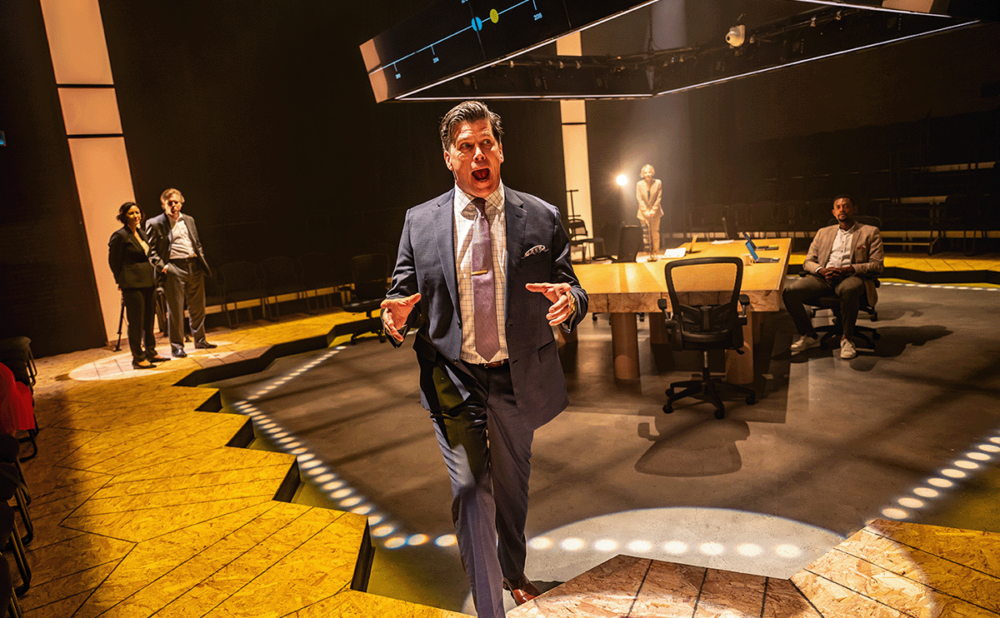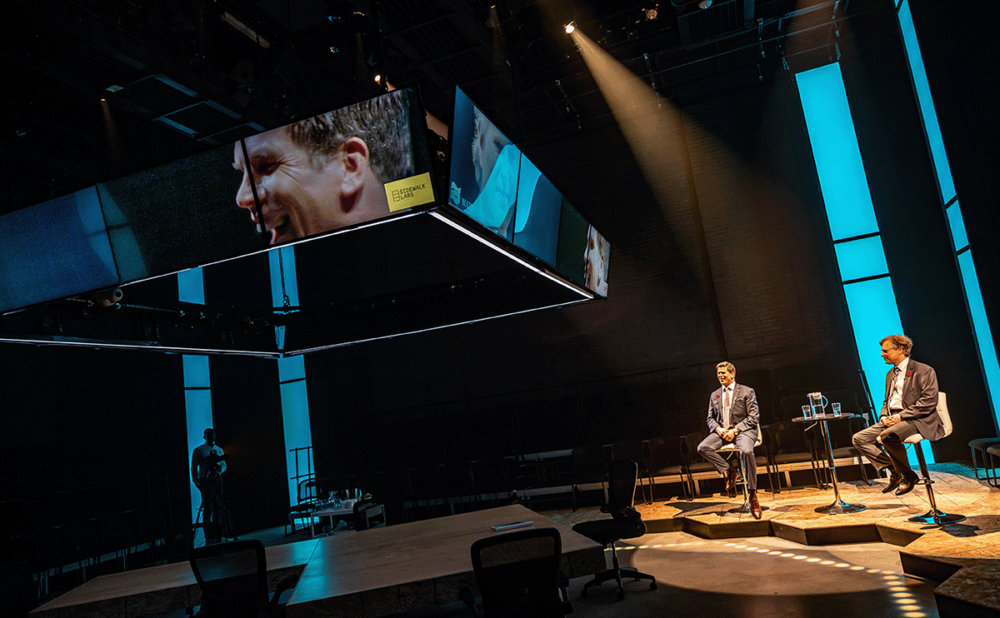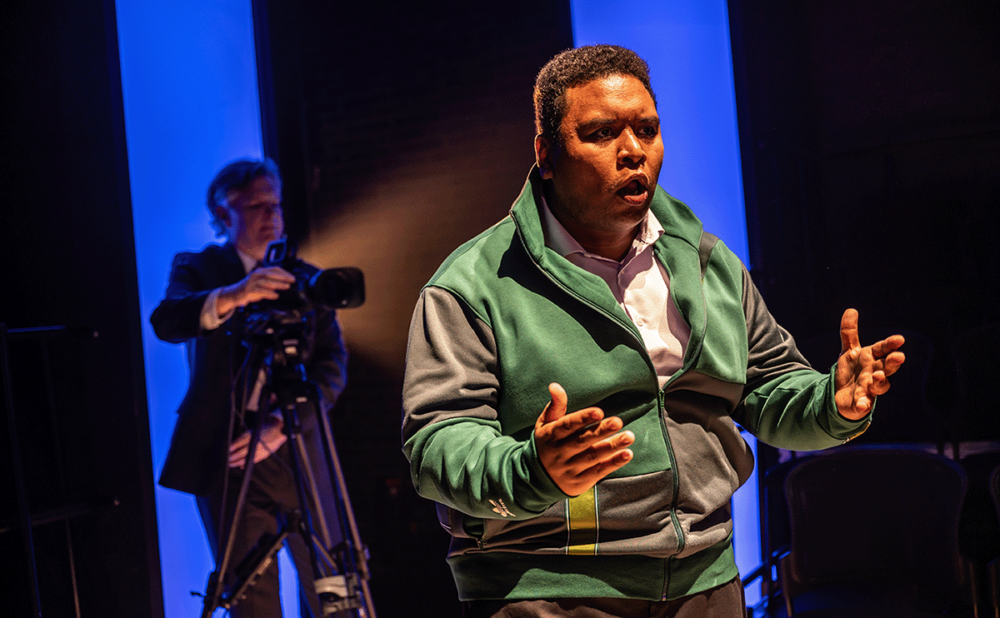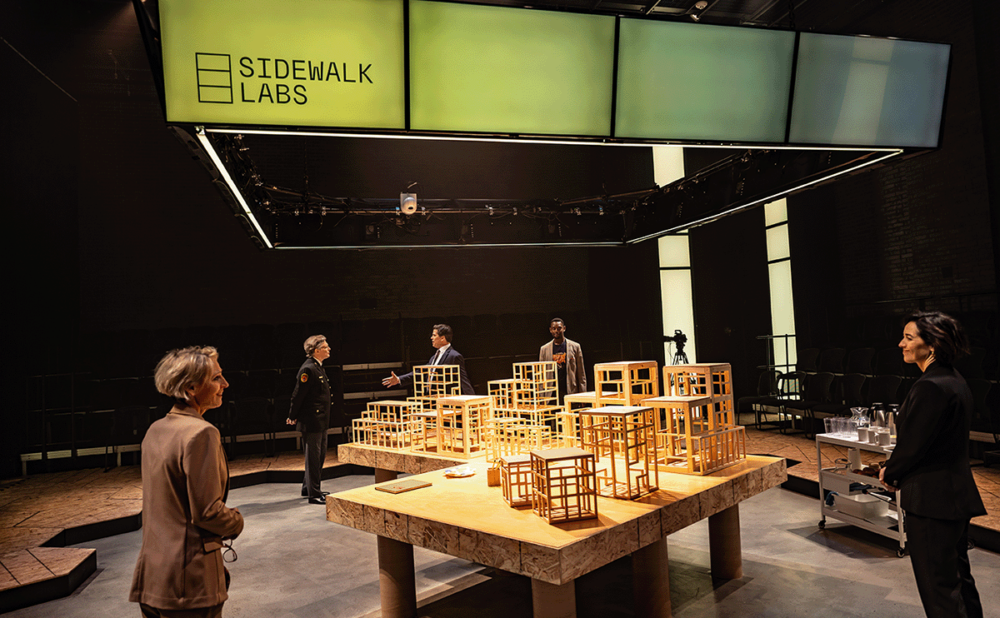‘The Master Plan’ at Crow’s Theatre is a smart play about a smart city
New Michael Healey satire chronicles Google’s failed attempt to build along the waterfront
What: The Master Plan
Where: Crow’s Theatre, 345 Carlaw Ave.
When: Now, until Oct. 8
Highlight: The show’s thrilling climax, which blends together flashing lights, booming sound design and unrestrained physicality.
Rating: NNNNN (out of 5)
Why you should go: The production’s design is as mature as any show you’re likely to see in Toronto this year.
ONTARIO GOT ITS OWN big tech docudrama this spring when BlackBerry hit screens with a depiction of the Waterloo-based cellphone company’s vertiginous rise and fall.
But The Master Plan, acclaimed Canadian playwright Michael Healey’s latest satire, chronicles an undertaking that never even got the chance to rise: Sidewalk Toronto, Google’s attempt to build a smart city along the waterfront. The play, expertly directed by Chris Abraham in its world premiere production at Crow’s Theatre, sautés and eats for dinner the ridiculous corporate and political figures behind the ill-fated project.
The main players are Waterfront Toronto — a government-created organization that owns “Quayside,” a 12-acre parcel of land by the water — and Sidewalk Labs, a Google urban planning subsidiary looking to buy and develop the area. From October 2017 to May 2020, the two corporations attempt to hash out a mutually beneficial plan for the site. Due to Sidewalk Labs’s arrogance, the City of Toronto’s inability to get things done and the media’s rush to condemn the project, these negotiations go in dizzying circles. The play mostly follows the path laid out by Josh O’Kane’s book Sideways: The City Google Couldn’t Buy, but Healey takes a few liberties: the show is narrated by a tree (Peter Fernandes) growing in a Toronto front lawn, for instance.
The four actors playing the Waterfront Toronto team — Tara Nicodemo (Kristina Verner, departmental vice-president), Philippa Domville (Meg Davis, chief development officer), Ben Carlson (Will Fleissig, CEO) and Yanna McIntosh (Helen Burstyn, board chair) — offer realistic portrayals of hardened, stressed-out Torontonians.
What’s brilliant is how different the Sidewalk Labs employees feel. As cocky CEO Dan Doctoroff, Mike Shara gives the most heightened and satirical performance in the show. He struts like a big shot on a power trip — I was reminded of Josh Brolin’s civil rights-violating police lieutenant in the film Inherent Vice — and rarely stops yelling. By contrast, young designer Cam Malagaam, gorgeously portrayed by Christopher Allen, is the heart of the piece. The utopian ideal of the smart city is almost overwhelmingly emotional to him. Though he and Dan are opposites, they share an American direct-ness to which the Waterfront Toronto folks have little access.
The production’s design is as mature as any show you’re likely to see in Toronto this year. Though most of the action happens around a wooden L-shaped table, Joshua Quinlan’s set also includes giant glowing panels that reach the theatre’s ceiling. In a European-feeling move, video screens designed by Amelia Scott hang above the stage. Sometimes these feature live footage from on-stage cameras, and sometimes they display diagrams that contextualize the action. When addressing the audience, the actors — especially Fernandes — pace the border of the in-the-round stage; Kimberly Purtell has lights follow their paths. It’s clearly tricky for the actors to match their movements to these pre-programmed lights — and this constant danger of not being lit parallels the danger of walking around a smart city littered with self-driving cars.
Healey dumps a lot of information on the audience during the first act of The Master Plan. There’s a reason for this: the project moves overwhelmingly fast for the people working on it, so the show overwhelms the viewer with details. But because Abraham’s maximalist staging already provides an over-the-top visual and aural assault, I’m not sure the text needs to work as hard as it does; as it stands, Act One feels a bit unfocused.
That said, Act Two is masterful. The show’s climax is one of the most thrilling theatrical sequences I’ve seen in a long time, maybe ever: it blends together flashing lights, booming sound design (by Thomas Ryder Payne) and unrestrained physicality to create a moment of total theatre. The highs of The Master Plan are almost impossibly high.
For the most part, the show is a comedy. Though jokes about the Gardiner Expressway and ice hockey border on pandering, most of the laughs land — and a gag about John Tory’s bad French never gets old.
Yet the show also asks a question of tragic proportions. A question that threatens to tumble the walls of the Streetcar Crowsnest and snake down Carlaw like a river of hot magma until it reaches the lakeshore, where it’ll smack into the E. coli-infested water, shoot up a column of steam and call out to the gods above: “Why the fuck can’t Toronto get anything done?”









